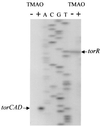The TorR high-affinity binding site plays a key role in both torR autoregulation and torCAD operon expression in Escherichia coli
- PMID: 10648521
- PMCID: PMC94371
- DOI: 10.1128/JB.182.4.961-966.2000
The TorR high-affinity binding site plays a key role in both torR autoregulation and torCAD operon expression in Escherichia coli
Abstract
In the presence of trimethylamine N-oxide (TMAO), the TorS-TorR two-component regulatory system induces the torCAD operon, which encodes the TMAO respiratory system of Escherichia coli. The sensor protein TorS detects TMAO and transphosphorylates the response regulator TorR which, in turn, activates transcription of torCAD. The torR gene and the torCAD operon are divergently transcribed, and the short torR-torC intergenic region contains four direct repeats (the tor boxes) which proved to be TorR binding sites. The tor box 1-box 2 region covers the torR transcription start site and constitutes a TorR high-affinity binding site, whereas box 3 and box 4 correspond to low-affinity binding sites. By using torR-lacZ operon fusions in different genetic backgrounds, we showed that the torR gene is negatively autoregulated. Surprisingly, TorR autoregulation is TMAO independent and still occurs in a torS mutant. In addition, this negative regulation involves only the TorR high-affinity binding site. Together, these data suggest that phosphorylated as well as unphosphorylated TorR binds the box 1-box 2 region in vivo, thus preventing RNA polymerase from binding to the torR promoter whatever the growth conditions. By changing the spacing between box 2 and box 3, we demonstrated that the DNA motifs of the high- and low-affinity binding sites must be close to each other and located on the same side of the DNA helix to allow induction of the torCAD operon. Thus, prior TorR binding to the box 1-box 2 region seems to allow cooperative binding of phosphorylated TorR to box 3 and box 4.
Figures



References
-
- Ansaldi M, Bordi C, Lepelletier M, Méjean V. TorC apocytochrome negatively autoregulates the trimethylamine N-oxide (TMAO) reductase operon in Escherichia coli. Mol Microbiol. 1999;33:284–295. - PubMed
-
- Barrett E L, Kwan H S. Bacterial reduction of trimethylamine oxide. Annu Rev Microbiol. 1985;39:131–149. - PubMed
-
- Dos Santos J P, Iobbi-Nivol C, Couillault C, Giordano G, Méjean V. Molecular analysis of the trimethylamine N-oxide (TMAO) reductase respiratory system from a Shewanella species. J Mol Biol. 1998;284:421–433. - PubMed
-
- Enderle P J, Farwell M A. Electroporation of freshly plated Escherichia coli and Pseudomonas aeruginosa cells. BioTechniques. 1998;25:954–958. - PubMed
Publication types
MeSH terms
Substances
LinkOut - more resources
Full Text Sources
Molecular Biology Databases

